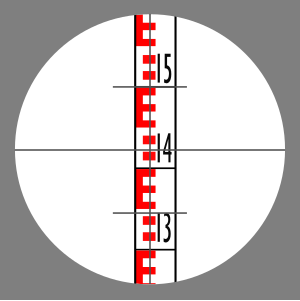This is an old revision of this page, as edited by 124.82.36.218 (talk) at 15:23, 21 June 2013 (→Rod construction and materials). The present address (URL) is a permanent link to this revision, which may differ significantly from the current revision.
Revision as of 15:23, 21 June 2013 by 124.82.36.218 (talk) (→Rod construction and materials)(diff) ← Previous revision | Latest revision (diff) | Newer revision → (diff)A level staff, also called levelling rod, is a graduated wooden or aluminum rod, the use of which permits the determination of differences in elevation.
Rod construction and materials

Metric graduations on the left, imperial on the right.
p;cm mark to a quarter of its height, yielding a reading with accuracy of 2.5 mm. On this side of the rod, the colours of the markings alternate between red and black with each meter of length.
The imperial graduations are in feet (large red numbers), tenths of a foot (small black numbers) and hundredths of a foot (unnumbered marks or spaces between the marks). The tenths of a foot point is indicated by the top of the long mark with the upward sloped end. The point halfway between tenths of a foot marks is indicated by the bottom of a medium length black mark with a downward sloped end. Each mark or space is approximately 3mm, yielding roughly the same accuracy as the metric rod.
Classes of rods

Rods come in two classes:
- Self-reading rods (sometimes called speaking rods).
- Target rods.
Self-reading rods are rods that are read by the person viewing the rod through the telescope of the instrument. The gradations are sufficiently clear to read with good accuracy. Target rods, on the other hand, are equipped with a target. The target is a round or oval plate marked in quarters in contrasting colours such as red and white in opposite quarters. A hole in the centre allows the instrument user to see the rod's scale. The target is adjusted by the rodman according to the instructions from the instrument man. When the target is set to align with the crosshairs of the instrument, the rodman records the level value. The target may have a vernier to allow fractional increments of the graduation to be read.
Topographer's rods
Topographer's rods are special purpose rods used to ease conducting topographical surveys. The rod has the zero mark at mid-height and the graduations increase in both directions away from the mid-height.
In use, the rod is adjusted so that the zero point is level with the instrument (or the surveyor's eye if he is using a hand level for low-resolution work). When placed at any point where the level is to be read, the value seen is the height above or below the viewer's position.
An alternative topographer's rod has the graduations numbered upwards from the base.
Stadia rods
A normal levelling rod can be used for stadia measures at shorter distances (up to about 125 m). For longer distances, special stadia rods are better suited. In order to provide good visibility at long distances, stadia rods are typically wider than levelling rods with larger markings. Since very fine gradations are not necessary for long sights, they may be left off the dedicated stadia rod.
See also
References
- Raymond Davis, Francis Foote, Joe Kelly, Surveying, Theory and Practice, McGraw-Hill Book Company, 1966 LC 64-66263